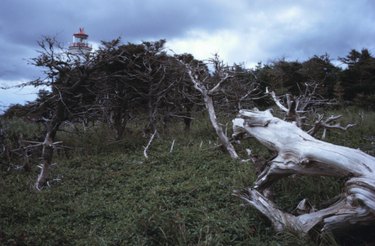
Douglas fir trees exhibiting weeping sap are plants displaying a natural defense against an insect infestation. Sap, also referred to as resin or sticky pitch, typically flows when insects attempt to enter the tree's bark. The sap blocks the hole and often saturates and kills the insect, explains Oregon State University. Examine your Douglas firs regularly as prevention and early diagnosis are your best bets for keeping trees healthy.
Preventive Care
Video of the Day
Maintaining vigorous trees is a key element in preventing insect infestations that lead to weeping sap. Grow Douglas fir trees in areas of the landscape that offer full sunlight for best growth and health. Tolerant to most soil types and either acid or alkaline pH levels, Douglas firs thrive in moist, well-drained soil. Dry soil can lead to diminished health and an inability to create enough sap which opens the door to insect infestation. Irrigate soil during dry warm weather. Grow these evergreens in USDA Hardiness Zones 5a to 6b for successful development.
Video of the Day
Problems
Sequoia pitch moths, Synanthedon sequoiae, are insects that attack Douglas fir trees as well as other hosts like pines . Look for resin dripping in colors like red, yellow, pink or gray as a sign of insect infestation. Pitch moths are clear winged insects measuring 3/4 inch long that lay eggs on Douglas fir trees. Larvae hatch from eggs, displaying white, pink or gray bodies and maturing into brown pupae measuring approximately 3/4 inch long.
Douglas fir beetles, Dendroctonus pseudotsuqae, also infest Douglas firs, as their name suggests, resulting in weeping sap. Look for red-orange frass, or bark shreds, that surround entry holes. Measuring 1/8 to 1/4 inches in length, the small adult beetles exhibit black bodies with red/brown wings while the white larvae display pale brown heads.
Damage
Sequoia pitch moth damage is minimal and cosmetic in nature as the larvae of these pests typically feed on the outer surfaces of the tree. Expect isolated incidences of branch die-back or breakage.
Douglas fir beetles form infestation in both fallen trees as well as living trees. Damage is often serious and widespread as uncontrolled beetles can kill up to 100 trees when they appear, though they typically attack only an isolated collection of plants, explains the U.S. Department of Agriculture . Beetle feeding results in yellowed foliage that turns red-brown before dropping to the ground. Trees often die as a result of beetle infestation.
Solution
To control sequoia pitch moths, remove and destroy affected plant parts to decrease the severity of infestation. Make clean cuts to avoid creating fresh wounds Scrape sap and larvae from the tree and kill the larvae. Practice caution around your tree, such as when mowing, to avoid creating wounds through which insects invade.
Control Douglas fir beetles through natural means as chemical controls like insecticide are not suggested, explains the USDA. Prune trees to thin branches; dense growth promotes infestation. Keep your landscape free of fallen trees and plant debris in which beetles live, increasing the spread of infestation and providing them a place to live before moving onto your fir. Contact your county extension agent to discuss potential control with pheromones to keep beetles from infesting healthy trees.
- University of California IPM Online; Sequoia Pitch Moth; S. H. Dreistadt, et al.; March 2004
- United States Department of Agriculture Forest Service; Forest Insect & Disease Leafleat 5 - Douglas-Fir Beetle; Richard F. Schmitz, et al.
- Oregon State University Extension Service; Why Are My Trees Dying?; John Punches
- University of Florida IFAS Extension; Pseudotsuga menziesii: Douglas-Fir; Edward F. Gilman; November 1993
- University of Washington Botanic Gardens